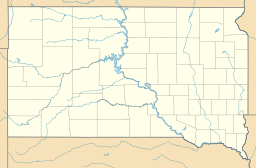Goose Lake (South Dakota) facts for kids
Quick facts for kids Goose Lake |
|
|---|---|
| Location | Codington County, South Dakota |
| Coordinates | 44°50′48″N 97°16′22″W / 44.8466112°N 97.2727864°W |
| Type | lake |
| Surface elevation | 1,716 feet (523 m) |
Goose Lake is a natural lake located in South Dakota, a state in the United States. It's a peaceful spot known for its wildlife. The lake gets its name because it's a favorite home for many geese.
Contents
Where is Goose Lake?
Goose Lake is found in Codington County, South Dakota. This county is in the eastern part of the state. The lake is surrounded by the beautiful natural landscapes of South Dakota.
South Dakota's Environment
South Dakota has a varied climate. It experiences warm summers and cold, snowy winters. This climate affects the lake throughout the year. The state is known for its wide-open spaces and many natural lakes.
Why is it Called Goose Lake?
The name "Goose Lake" is quite simple! It's named after the many geese that live there. Geese are large water birds. They often gather in large groups on and around the lake.
Geese and Their Habitat
Geese are migratory birds. This means they travel long distances between their breeding and wintering grounds. Lakes like Goose Lake provide important resting and feeding spots for them. They find plenty of food and safe places to raise their young here.
Life at Goose Lake
Goose Lake is an important habitat for many animals and plants. Besides geese, other birds, fish, and small creatures call the lake home. The plants in and around the water also play a big role.
Animals of the Lake
- Birds: Besides geese, you might see ducks, herons, and other waterfowl. These birds feed on fish and insects in the lake.
- Fish: The lake likely supports various fish species. These fish are a food source for birds and other animals.
- Mammals: Small mammals like muskrats or raccoons might live near the shore. They come to the lake for water and food.
Plants of the Lake
- Aquatic Plants: Plants that grow in the water provide shelter for fish. They also offer food for some waterfowl.
- Shoreline Plants: Reeds and grasses grow along the edges of the lake. These plants help prevent soil from washing into the water. They also provide nesting sites for birds.
Understanding Lakes
Lakes are large bodies of water surrounded by land. They are important parts of Earth's natural systems. Goose Lake is a natural lake, meaning it formed without human help.
How Lakes Form
Many natural lakes form in different ways:
- Glaciers: Some lakes are formed by glaciers. As glaciers move, they carve out depressions in the land. When the ice melts, these depressions fill with water.
- Volcanic Activity: Craters of inactive volcanoes can fill with water. This creates crater lakes.
- River Changes: Rivers can sometimes create oxbow lakes. This happens when a bend in a river gets cut off.
Importance of Lakes
Lakes like Goose Lake are very important.
- They provide homes for many plants and animals.
- They can be a source of fresh water.
- They offer places for people to enjoy nature.
- They help regulate local climates.



